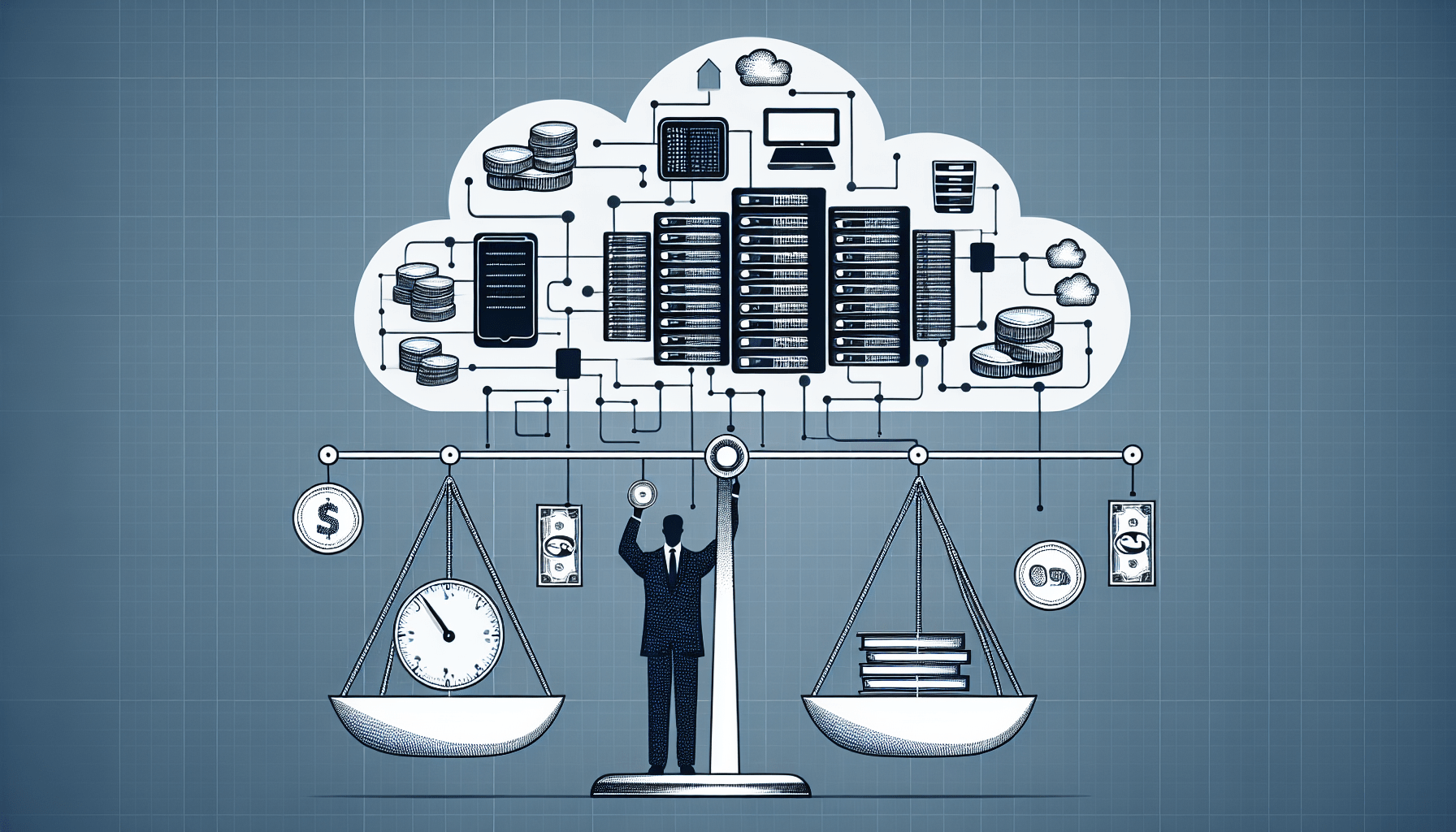In today’s digital age, website security and performance are two critical factors that contribute to the success of any online platform. Ensuring that your website is secure from potential threats while maintaining optimal performance is a delicate balancing act. With cyber attacks becoming increasingly sophisticated and users demanding faster loading times, finding the right balance between website security and performance is more crucial than ever. In this article, we will explore the challenges faced by website owners in achieving this delicate equilibrium and provide practical tips to help you find the right balance for your website.
Understanding the importance of website security and performance
Website security and performance are two crucial aspects of running a successful website. In today’s digital age, where cyber threats are rampant and user expectations for fast and reliable websites are high, it is essential to understand the significance of both security and performance.
Defining website security
Website security refers to the measures and practices put in place to protect a website and its users from unauthorized access, data breaches, and other cyber threats. It involves implementing security measures like encryption, firewalls, and regular vulnerability testing to ensure the safety of sensitive information and maintain the integrity of the website.
Exploring the concept of website performance
Website performance, on the other hand, focuses on how well a website functions and how quickly it delivers content to users. It encompasses factors such as page loading speed, responsiveness, and overall user experience. A well-performing website is vital for user satisfaction, search engine rankings, and overall success in the online marketplace.
The relationship between security and performance
While website security and performance may seem like separate concerns, they are closely intertwined. A lack of security measures can compromise a website’s performance, and likewise, excessive security measures can negatively impact performance. Balancing both aspects is essential to provide a seamless and secure experience for website visitors.
The impact of website security on user experience
Website security plays a significant role in enhancing the user experience. When users visit a website, they expect their personal information to be handled securely and their privacy protected. By implementing robust security measures, website owners can ensure data privacy and protection, prevent unauthorized access to user information, and build trust and credibility with their audience.
Ensuring data privacy and protection
One of the primary concerns for users today is the protection of their personal information. Websites that prioritize security are more likely to instill confidence in users, knowing that their data is being handled responsibly. Implementing measures such as SSL/TLS encryption and secure coding practices can help safeguard sensitive information and maintain user trust.
Preventing unauthorized access
Unauthorized access to a website can have severe consequences, including data breaches and unauthorized use of user accounts. By implementing measures like strong authentication protocols and regularly updating and patching software, website owners can significantly reduce the risk of unauthorized access. This not only protects user data but also helps maintain the overall integrity and reputation of the website.
Building trust and credibility with users
A secure website demonstrates to users that their safety and privacy are a priority. This, in turn, builds trust and credibility, which are essential for establishing and maintaining a loyal user base. When users feel confident and secure while interacting with a website, they are more likely to engage with its content, make purchases, and share positive experiences with others.
The effect of website performance on user satisfaction
Website performance directly influences user satisfaction. Slow-loading pages, unresponsive designs, and other performance-related issues can frustrate users and lead to a negative user experience. Therefore, it is crucial to prioritize website performance to ensure that users have a seamless and enjoyable interaction with the website.
The need for fast-loading pages
In today’s fast-paced digital environment, users have little patience for slow-loading pages. Research shows that users tend to abandon websites that take more than a few seconds to load, resulting in higher bounce rates and missed opportunities for conversions. Fast-loading pages create a positive user experience, reduce frustration, and increase the likelihood of users staying on the website.
Optimizing website speed
Optimizing website speed involves various techniques and strategies aimed at reducing page load times and improving overall performance. This may include optimizing images and files, minifying CSS, JavaScript, and HTML, leveraging browser caching, and employing advanced caching mechanisms like content delivery networks (CDNs). By implementing these performance optimization techniques, website owners can provide a faster and more seamless browsing experience to their users.
Reducing bounce rates and improving conversions
High bounce rates, which occur when users leave a website without interacting with its content, can negatively impact conversions and overall business success. Slow website performance is often one of the leading causes of high bounce rates. By improving website performance, website owners can reduce bounce rates and increase the chances of converting casual visitors into engaged users or customers.
Common security measures that can impact website performance
While implementing security measures is crucial for protecting a website, it is important to be mindful of their potential impact on website performance. Some security measures can introduce additional overhead and slow down the website if implemented improperly. Therefore, it is essential to find the right balance between security and performance.
Implementing SSL/TLS encryption
SSL/TLS encryption is a standard security measure that ensures secure communication between a user’s browser and the website. While encryption is essential for protecting sensitive information, it can introduce additional overhead and potentially slow down website performance. It is crucial to implement SSL/TLS correctly and leverage optimized encryption protocols to minimize any performance impact.
Using firewalls and web application firewalls
Firewalls and web application firewalls (WAFs) are critical security measures that monitor and filter incoming and outgoing network traffic to protect against unauthorized access and malicious attacks. However, the implementation of firewalls and WAFs can introduce additional network latency, impacting website performance. Careful configuration and tuning of these security measures is necessary to strike a balance between security and performance.
Regular security audits and vulnerability testing
Regular security audits and vulnerability testing are essential for identifying potential security weaknesses and ensuring that website security measures are up to date. However, these audits and tests can be resource-intensive and potentially impact website performance during the testing process. It is crucial to schedule these activities during low-traffic periods and optimize the testing procedures to minimize any negative impact on performance.
Strategies to balance website security and performance
Finding the right balance between website security and performance requires a strategic approach. It involves evaluating the sensitivity of user data, implementing caching and content delivery networks (CDNs), and selecting the appropriate hosting solution.
Evaluating the sensitivity of user data
Not all websites handle the same level of sensitive user data. By evaluating the sensitivity of the data being collected, website owners can determine the appropriate level of security measures needed without compromising performance. For example, a website that collects and stores financial information may require stronger security measures compared to a blog that collects only basic contact information.
Implementing caching and content delivery networks (CDNs)
Caching involves storing website data and content in a temporary storage location to reduce the time it takes to retrieve and deliver that data to users. Content delivery networks (CDNs) further enhance caching by distributing website content across multiple servers geographically. By implementing caching and CDNs, website owners can significantly improve performance without compromising security.
Finding the right hosting solution
A website’s hosting solution plays a crucial role in both security and performance. Shared hosting, which involves sharing server resources with other websites, may be more cost-effective but can result in slower performance if other websites on the same server experience high traffic. Opting for dedicated hosting or virtual private servers (VPS) can provide better performance and security but may come with higher costs. It is essential to choose a hosting solution that aligns with the specific needs of the website.
Prioritizing website security without compromising performance
Website security should always be a top priority, but it should not come at the expense of performance. By implementing specific security practices, website owners can enhance security without sacrificing performance.
Utilizing secure coding practices
Secure coding practices involve writing code that is resistant to common security vulnerabilities and exploits. By adopting these practices, such as input validation and parameterized queries, website owners can improve security without negatively impacting performance.
Implementing multi-factor authentication
Multi-factor authentication (MFA) adds an extra layer of security by requiring users to provide two or more pieces of evidence to verify their identity. This can include something they know (e.g., a password), something they have (e.g., a physical token), or something they are (e.g., biometric data). While MFA enhances security, it should be implemented in a way that doesn’t overly burden the user experience or introduce unnecessary complexity.
Regularly updating and patching software
Software updates and patches often include security fixes that address known vulnerabilities. Regularly updating and patching software, including content management systems (CMS), plugins, and themes, is essential for maintaining a secure website. However, website owners should test these updates before deployment to ensure that they do not introduce any performance issues or conflicts with existing functionality.
Improving website performance without sacrificing security
Enhancing website performance does not have to come at the expense of security. By implementing specific optimization strategies and techniques, website owners can achieve both improved performance and robust security.
Optimizing images and files
High-resolution images and large files can significantly slow down page load times. Optimizing images by reducing their size and using appropriate file formats, and minifying CSS, JavaScript, and HTML by removing unnecessary code and whitespace, can greatly improve website performance without compromising security.
Minifying CSS, JavaScript, and HTML
Minifying involves removing unnecessary code, whitespace, and comments from CSS, JavaScript, and HTML files. By reducing file sizes and improving code efficiency, minification can enhance website performance. It is important to verify that the minified files do not break any functionality or introduce security vulnerabilities.
Implementing HTTP/2 and resource prioritization
HTTP/2 is the latest version of the Hypertext Transfer Protocol, designed to improve website performance by enabling more efficient communication between the server and the browser. HTTP/2 supports features like multiplexing and server push, which enhance performance without compromising security. Implementing HTTP/2 and prioritizing critical resources can significantly improve website performance.
The role of monitoring and performance testing
Monitoring website security and performance is an ongoing process that ensures optimal functionality and identifies any issues or bottlenecks that may arise. By utilizing monitoring tools and conducting performance tests, website owners can proactively address any potential security or performance issues.
Utilizing website monitoring tools
Website monitoring tools help track website availability, uptime, and performance metrics. By utilizing these tools, website owners can identify and resolve any security or performance issues promptly. Monitoring tools can provide valuable insights into server response times, page load times, and other performance metrics, allowing website owners to make informed decisions to optimize performance.
Conducting performance tests
Performance testing involves simulating real-world scenarios to evaluate a website’s responsiveness and identify potential bottlenecks. By conducting performance tests, website owners can pinpoint areas that require optimization and mitigate any potential issues before they impact the user experience. It is important to conduct performance tests regularly and after any significant changes to the website to ensure ongoing optimization.
Identifying and resolving performance bottlenecks
Monitoring website performance and conducting performance tests can reveal potential bottlenecks that hinder performance. These bottlenecks can be caused by factors such as slow server response times, excessive database queries, or resource-intensive scripts. By identifying and resolving these bottlenecks, website owners can improve website performance without sacrificing security.
The importance of ongoing maintenance and updates
Maintaining website security and performance requires continuous effort and attention. Regularly reviewing and updating security measures, monitoring website performance, and staying informed about emerging threats and technologies are crucial to ensuring the long-term success of a website.
Regularly reviewing and updating security measures
As cyber threats continue to evolve, it is essential to regularly review and update security measures to protect against new vulnerabilities and exploits. This involves staying up to date with security best practices, applying software updates and patches promptly, and implementing additional security measures as needed. Regular security audits and vulnerability testing can help identify any potential weaknesses that require attention.
Monitoring website performance and making necessary adjustments
Website performance can fluctuate over time due to various factors like increased traffic, changes in user behavior, or updates to the website itself. Regularly monitoring performance metrics and user feedback can help identify any performance issues that may arise and allow website owners to make necessary adjustments. By proactively addressing performance concerns, website owners can ensure a consistent and optimized user experience.
Staying informed about emerging threats and technologies
The landscape of website security and performance is constantly evolving. Staying informed about emerging threats and technologies is crucial for maintaining a secure and high-performing website. By keeping up with industry trends, attending webinars or conferences, and actively engaging with cybersecurity and performance communities, website owners can continuously enhance their knowledge and adapt their strategies.
Strategies for finding the right balance
Finding the right balance between website security and performance is a continuous process that requires careful evaluation and adjustment. The following strategies can help website owners navigate this balancing act:
Assessing the unique needs of your website
Every website has unique requirements and considerations. By assessing the specific needs of the website, including the types of data being collected and the target audience, website owners can determine the most suitable security and performance measures. Customizing security and performance strategies to align with these needs ensures an optimal balance.
Seeking expert advice and consultation
Navigating the complexities of website security and performance can be challenging, especially for those without specialized knowledge or expertise. Seeking advice and consultation from cybersecurity and performance professionals can provide valuable insights and guidance. These experts can assess the specific requirements of a website and recommend tailored solutions to achieve the desired balance.
Continuous monitoring and optimization
Website security and performance are not one-time endeavors; they require continuous monitoring and optimization. By regularly monitoring security measures, website performance, and emerging trends, website owners can proactively address any issues or opportunities for improvement. This continuous effort ensures that the website remains secure, high-performing, and adaptable to changing circumstances.
In conclusion, website security and performance are intricately linked and essential for providing a positive user experience while protecting sensitive information. Finding the right balance between security and performance involves assessing the unique needs of the website, implementing appropriate measures, and continuously monitoring and optimizing both aspects. By prioritizing security without compromising performance and enhancing performance without sacrificing security, website owners can create a secure and high-performing online presence that instills confidence in their users.













